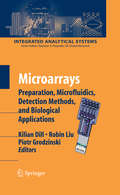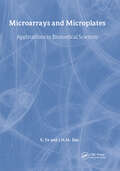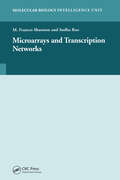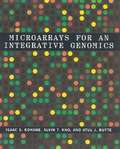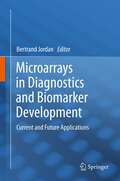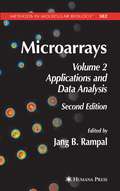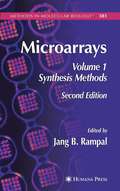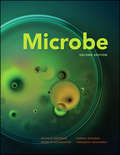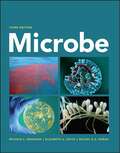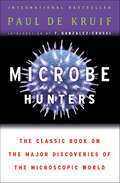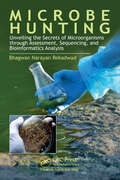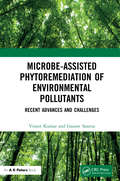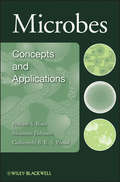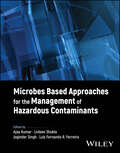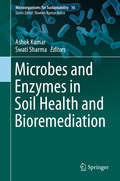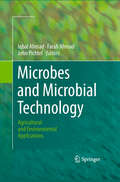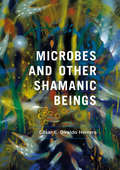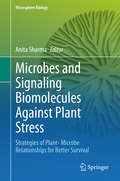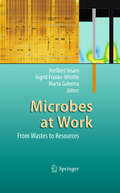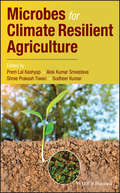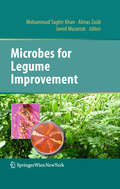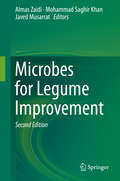- Table View
- List View
Microarrays
by Piotr Grodzinsky Robin Liu Kilian DillCombinatorial chemistry is used to find materials that form sensor microarrays. This book discusses the fundamentals, and then proceeds to the many applications of microarrays, from measuring gene expression (DNA microarrays) to protein-protein interactions, peptide chemistry, carbodhydrate chemistry, electrochemical detection, and microfluidics.
Microarrays and Microplates: Applications in Biomedical Sciences (Advanced Methods Ser.)
by S. Ye I.N.M. DayThe 'Advanced Methods' series is intended for advanced undergraduates, postgraduates and established research scientists. Titles in the series are designed to cover current important areas of research in life sciences, and include both theoretical background and detailed protocols. The aim is to give researchers sufficient theory, supported by references, to take the given protocols and adapt them to their particular experimental systems.Microarrays and Microplates title looks at the new microarray and microplate-based technologies which facilitate large-scale analysis of DNA sequence variants, mRNA molecules and proteins. The book provides a review of the various methodologies being used to identify genetic variants and gene regulation and guides readers through both the application of these methodologies and experimental procedures.
Microarrays and Transcription Networks
by M. Francis Shannon Sudha RaoWhile every cell of an organism has an identical genomic content, extremely complex networks exist to tailor the genomic output to the needs of that cell. This program of gene expression is different for every cell type and stage of development. In addition, the cell can respond to its environment by modulating its gene expression program in a fairly dramatic manner. For many decades gene transcription has been investigated in systems from bacteria to mammalian cells and along the way many landmark findings have set new paradigms that often apply across wide evolutionary distances. Studying individual genes, however, especially in mammalian systems has been a painstaking business and although we know the transcription activators and other complexes that control specific genes in minute detail, generalizing these findings has often proven to be difficult. It has become clear that transcription factors do not operate alone but form complex networks in the cell. If one component of this complexity is disturbed then there are repercussions across the entire network, but it has been impossible to study these networks until very recently. The advent of microarray technology within the last decade has revolutionized how we study gene transcription. There are several types of array technology that essentially screen for relative mRNA levels for many thousands of genes at once. We do not focus here on the technology as this has become routine and is available to many researchers. Microarray technology has given us the ability to measure the entire gene expression program of a cell in a single experiment and compare it to other cells thus allowing a global view of cell behaviour at the level of gene transcription. Expression profiling, as this endeavour has become known, is now a relatively simple undertaking and hundreds, probably thousands of papers have been published demonstrating the power of this technology. Expression profiling has been applied to many diverse biological problems and is also being developed as a method for disease diagnosis especially in the cancer classification field. There are constant improvements or modified uses of the technology that are allowing more and more high throughput experiments to be carried out.
Microarrays for an Integrative Genomics
by Isaac S. Kohane Alvin Kho Atul J. ButteFunctional genomics--the deconstruction of the genome to determine the biological function of genes and gene interactions--is one of the most fruitful new areas of biology. The growing use of DNA microarrays allows researchers to assess the expression of tens of thousands of genes at a time. This quantitative change has led to qualitative progress in our ability to understand regulatory processes at the cellular level. This book provides a systematic introduction to the use of DNA microarrays as an investigative tool for functional genomics. The presentation is appropriate for readers from biology or bioinformatics. After presenting a framework for the design of microarray-driven functional genomics experiments, the book discusses the foundations for analyzing microarray data sets, genomic data-mining, the creation of standardized nomenclature and data models, clinical applications of functional genomics research, and the future of functional genomics.
Microarrays in Diagnostics and Biomarker Development
by Bertrand JordanMicroarray technology has made strong progress over the past decade, and there have also been significant changes in application areas, from nucleic acids to proteomics and from research to clinical applications. This book provides a comprehensive overview of microarrays in diagnostics and biomarker development, covering DNA, peptide, protein and tissue arrays. The focus is on entities that are in actual clinical use, or quite close, and on recent developments, such as peptide and aptamer arrays. A further topic is the miniaturisation towards "nanoarrays", which is expected to have great potential in clinical applications. Relevant issues of bioinformatics and statistical analysis of array data are discussed in detail, as well as the barriers to the commercialisation of array-based tests and the vexing IP issues involved. Thus, the book should be very useful tor active array users as well as to newcomers seeking to make the best choice between different technologies.
Microarrays in Diagnostics and Biomarker Development: Current and Future Applications
by Bertrand JordanMicroarray technology has made strong progress over the past decade, and there have also been significant changes in application areas, from nucleic acids to proteomics and from research to clinical applications. This book provides a comprehensive overview of microarrays in diagnostics and biomarker development, covering DNA, peptide, protein and tissue arrays. The focus is on entities that are in actual clinical use, or quite close, and on recent developments, such as peptide and aptamer arrays. A further topic is the miniaturisation towards “nanoarrays”, which is expected to have great potential in clinical applications. Relevant issues of bioinformatics and statistical analysis of array data are discussed in detail, as well as the barriers to the commercialisation of array-based tests and the vexing IP issues involved. Thus, the book should be very useful tor active array users as well as to newcomers seeking to make the best choice between different technologies.
Microarrays, Volume 2, Applications and Data Analysis
by Jang B. RampalMicroarray Technology, Volumes 1 and 2, present information in designing and fabricating arrays and binding studies with biological analytes. This is done while providing the reader with a broad description of microarray technology tools and their potential applications. The first volume deals with methods and protocols for the preparation of microarrays. The second volume details applications and data analysis, which is important in analyzing the enormous data coming out of microarray experiments. <P><P>Microarray Technology, Volumes 1 and 2, provide ample information to all levels of scientists from novice to those intimately familiar with array technology.
Microarrays, Volume I: Synthesis Methods
by Jang B. RampalMicroarray Technology, Volumes 1 and 2, present information in designing and fabricating arrays and binding studies with biological analytes. This is done while providing the reader with a broad description of microarray technology tools and their potential applications. The first volume deals with methods and protocols for the preparation of microarrays. The second volume details applications and data analysis, which is important in analyzing the enormous data coming out of microarray experiments. <P><P>Microarray Technology, Volumes 1 and 2, provide ample information to all levels of scientists from novice to those intimately familiar with array technology.
Microbe (ASM Books)
by Michele Swanson Moselio Schaechter Gemma Reguera Frederick C. NeidhardtBrings the excitement, breadth, and power of the modern microbial sciences to the next generation of students and scientists. This new edition of Microbeis an eloquent and highly readable introduction to microbiology that will engage and excite science majors and pre-health professionals. The authors, all prominent scientists, have carefully crafted this lively narrative to bring key microbiology concepts to life and promote a lifelong passion for the microbial sciences. Far more than a comprehensive reference book, Microbeis replete with case studies, ranging from sauerkraut fermentation to the cholera outbreak in Haiti, that illustrate the impact of key microbiology concepts on real-world scenarios. To further engage students and deepen their understanding of both the principles and practice of science, each chapter includes multiple active learning exercises that encourage students to demonstrate their understanding and application of concepts, as well as video, spoken, and written resources. Questions are posed throughout the book to introduce the next key concept and to prompt students to actively participate in the learning experience. An equally valuable tool for instructors who teach a traditional lecture format and those who emphasize active learning in their classroom, Microbeintegrates key concepts, learning outcomes, and fundamental statements directly from the ASM Recommended Curriculum Guidelines for Undergraduate Microbiology Education.
Microbe (Asm Bks.)
by Michele S. Swanson Elizabeth A. Joyce Rachel E. A. HorakThis third edition of the bestselling Microbe textbook is an eloquent and highly readable introduction to microbiology that will engage and excite science majors and pre-health professionals. The authors have carefully crafted a lively narrative with stunning, detailed illustrations to bring key concepts to life and promote a lifelong passion for the microbial sciences. Microbe is replete with case studies, ranging from a MRSA (methicillin-resistant Staphylococcus aureus) outbreak in an NFL locker room to the search for life outside of Earth, that illustrate relevant microbiology concepts in real-world scenarios. To further engage students and deepen their understanding of both the principles and practice of science, each chapter includes activities that encourage students to demonstrate and apply their knowledge of the topics presented. Questions are posed throughout each chapter to introduce important subjects and to prompt students to actively participate in the learning experience. This new edition also features highlight boxes exploring the varied roles and applications of microbes at work in our world as well as profiles of the diverse array of individuals who work in and adjacent to the field of microbiology. An equally valuable tool for instructors of all classroom modalities, Microbe integrates key concepts, learning outcomes, and fundamental statements directly from the ASM Curriculum Guidelines for Undergraduate Microbiology. The new edition also provides robust instructor materials, including slides with figures and tables from the text, access to more than 250 peer-reviewed questions for microbiology education, and an instructors’ manual featuring answers for end-of-chapter questions as well as supplemental exercises and resources to challenge students to dig deeper into their understanding of the material.
Microbe Hunters: The Classic Book on the Major Discoveries of the Microscopic World
by Paul de KruifAn international bestseller, translated into 18 languages, Paul de Kruif's classic account of the first scientists to see and learn about the microscopic world continues to fascinate audiences. This is a timeless dramatization of the scientists, bacteriologists, doctors, and medical technicians who discovered the microbes and invented the vaccines to counter them. De Kruif writes about how seemingly simple but really fundamental discoveries of science—for instance, how a microbe was first viewed in a clear drop of rain water, and when, for the first time, Louis Pasteur discovered that a simple vaccine could save a man from the ravages of rabies by attacking the microbes that cause it. "It manages to delight, and frequently to entrance, old and new readers [and] continues to engage our hearts and minds today with an indescribable brand of affectionate sympathy." –– F. Gonzalez-Crussi, from the Introduction.
Microbe Hunting: Unveiling the Secrets of Microorganisms through Assessment, Sequencing, and Bioinformatics Analysis
by Bhagwan Narayan Rekadwad"Microbe Hunting: Unveiling the Secrets of Microorganisms through Assessment, Sequencing, and Bioinformatics Analysis" embarks on a captivating expedition into the unseen world of microorganisms. This insightful journey navigates the intricate realms of microbial diversity, unwrapping the significance of ecological roles and technological advancements. Through the lens of assessment techniques, the book unveils the art of sample preparation and the transformative power of sequencing technologies, shedding light on the uncharted territories of bioinformatics analysis. From decoding taxonomic landscapes to unearthing functional treasures, this book traverses metagenomics and its benefits for human. With ethical considerations and glimpses into the future, the voyage culminates, offering a profound understanding of the microbial universe and its boundless potential.
Microbe-Assisted Phytoremediation of Environmental Pollutants: Recent Advances and Challenges
by Vineet Kumar Gaurav SaxenaMicrobe-Assisted Phytoremediation of Environmental Pollutants: Recent Advances and Challenges provides comprehensive information on the principles and practical knowledge of microbe-assisted phytoremediation of organic and inorganic pollutants for environmental safety. This book describes the physiological, biochemical, microbiological, and molecular basis of microbe-assisted phytoremediation and contains many relevant topics to fill the gaps in developing an understanding of microbe-assisted phytoremediation of environmental pollutants. The book provides state-of-the-art knowledge on fundamental, practical, and purposeful utilization of plant-associated bacteria (plant growth-promoting rhizobacteria [PGPR] and endophytes) and arbuscular mycorrhizal fungi for plant-growth promotion and enhanced phytoremediation of environmental pollutants in the contaminated matrix. Features: Provides a state-of-the-art overview of microbe-assisted phytoremediation Emphasizes the roles of PGPR, endophytes, and mycorrhizal fungi in assisted phytoremediation Elucidates biochemical and molecular mechanisms of microbe-assisted phytoremediation Details field studies and success stories of microbe-assisted phytoremediation Explores advances, challenges, and future directions in microbe-assisted phytoremediation The book serves as a valuable resource for researchers, ecotoxicologists, environmental scientists and engineers, environmental microbiologists and biotechnologists, environmental health and risk scientists, environmental science managers and administrators, remediation practitioners, environmental policymakers, and students at the postgraduate and doctoral levels in the relevant fields who wish to work on microbe-assisted phytoremediation of pollutants for environmental safety and sustainability.
Microbes
by Mousumi Debnath G. B. Prasad Prakash S. BisenAn accessible introduction to the world of microbes--from basic microbe biology through industrial applicationsMicrobes affect our lives in a variety of ways--playing an important role in our health, food, agriculture, and environment. While some microbes are beneficial, others are pathogenic or opportunistic.Microbes: Concepts and Applications describes basic microbe biology and identification and shows not only how they operate in the subfields of medicine, biotechnology, environmental science, bioengineering, agriculture, and food science, but how they can be harnessed as a resource. It provides readers with a solid grasp of etiologic agents, pathogenic processes, epidemiology, and the role of microbes as therapeutic agents.Placing a major emphasis on omics technology, the book covers recent developments in the arena of microbes and discusses their role in industry and agriculture, as well as in related fields such as immunology, cell biology, and molecular biology. It offers complete discussions of the major bacterial, viral, fungal, and parasitic pathogens; includes information on emerging infectious diseases, antibiotic resistance, and bioterrorism; and talks about the future challenges in microbiology.The most complete treatment of microbial biology available, Microbes features eye-opening chapters on:Human and Microbial WorldGene Technology: Application and TechniquesMolecular Diagnostic and Medical MicrobiologyIdentification and Classification of MicrobesDiversity of MicroorganismsMicrobes in AgricultureMicrobes as a Tool for Industry and ResearchComplete with charts and figures, this book is an invaluable textbook for university teachers, students, researchers, and people everywhere who care about microorganisms.
Microbes Based Approaches for the Management of Hazardous Contaminants
by Ajay Kumar Joginder Singh Livleen Shukla Luiz Fernando R. FerreiraLearn the various microbiological aspects one deals with in environment management and the remediation of toxic contaminants in the environment In recent years, the accumulation of hazardous contaminants has caused a broad-based deterioration in global environmental quality. These have had wide-ranging negative social impacts, affecting climate, soil and water ecosystems, and more. As traditional methods of contaminant mitigation have proven inadequate to the task, microbial-based remediation offers the clearest, most environmentally friendly path forward for this crucial aspect of global environmental stewardship. Microbes Based Approaches for the Management of Hazardous Contaminants offers comprehensive coverage of novel and indigenous microbes and their applications in contaminant mitigation. Surveying all the major microbial products and methods for degrading and remediating hazardous pollutants, it offers a key tool in the fight against global environmental degradation. The result is a cutting-edge introduction to an essential subject. Microbes Based Approaches for the Management of Hazardous Contaminants will also find: Current and future approaches to microbial degradation Detailed discussion of biofilms, exopolysaccharides, enzymes, metabolites, and many more Coverage of metabolic engineering as an alternative strategy Microbes Based Approaches for the Management of Hazardous Contaminants is ideal for those working in the field for the application of microbes in the remediation of hazardous pollutants and environment management, particularly those interested in environmental sciences, microbiology and microbial technology, environmental biotechnology, and molecular biology.
Microbes and Enzymes in Soil Health and Bioremediation (Microorganisms for Sustainability #16)
by Ashok Kumar Swati SharmaMicrobial enzymes play a vital role in maintaining soil health and removing pollutants from contaminated land. Soil microflora is closely associated with maintaining soil fertility, and the use of chemical pesticides, fertilizers and other volatile sprays in agriculture threatens the health ofthe microbial population in the soil. Every single particle of healthy soil contains millions of bacteria, which interact with the nutrients available, sustaining the nutrient cycle and making this microflora an essential component of life on earth. How do microbes help in the nutrient cycle? Either by intracellular digestion of macromolecules and converting these into smaller units in their metabolic pathways, or by secreting enzymes into the extracellular environment to facilitate the conversion of complex macromolecules into micro-molecules that can be easily absorbed by other living species. To meet demands for energy and food for the growing global population, it is important to protect agricultural land from contamination and maintain its productivity. Heavy metal ions from contaminated land canenter crops, fish or aquatic organismsvia contaminated water, and theseare then taken up by the human body, where they can accumulate and alter the normal microflora.The microbiological component of the soil is ahighly complex system and is still not fully understood. How do microbes survive in the changing physicochemical environment of soil?. This book helps readers understand the mechanism, various routes of microbialsoil remediation, the interactionsof different genera, and how microbial enzymes support the sustainable restoration of healthy soil.
Microbes and Microbial Technology
by Iqbal Ahmad John Pichtel Farah AhmadThis book focuses on successful application of microbial biotechnology in areas such as medicine, agriculture, environment and human health.
Microbes and Oral Squamous Cell Carcinoma: A Network Spanning Infection and Inflammation
by Samapika RoutrayThis book helps in understanding the relationship between microorganisms and oral carcinogenesis, and the possible oncogenic mechanisms enhancing the association. The book highlights the association between oral cancer, primarily oral squamous cell carcinoma (OSCC), a major global health problem with high incidence and low survival rates with infection and inflammation. Establishing the association of the oral microbiome with cancer risk may lead to significant advances in the understanding cancer etiology, potentially opening a new research paradigm for cancer prevention.The book takes the readers through interesting topics such as the epidemiology and etiology of OSCC, the hallmarks of cancer, and the role of inflammation in OCSS. It presents the difference between the normal and diseased oral microbiome. It further describes the carcino-pathogenesis of various groups. Finally, it discusses the clinical correlation of the observations and what the future looks like for this area of research.The book is interesting for medical students, researchers and clinicians, alike. The knowledge from the book can be exploited practically and used for designing further experiments.
Microbes and Other Shamanic Beings
by César E. Giraldo HerreraShamanism is commonly understood through reference to spirits and souls. However, these terms were introduced by Christian missionaries as part of the colonial effort of conversion. So, rather than trying to comprehend shamanism through medieval European concepts, this book examines it through ideas that started developing in the West after encountering Amerindian shamans. Microbes and Other Shamanic Beings develops three major arguments: First, since their earliest accounts Amerindian shamanic notions have had more in common with current microbial ecology than with Christian religious beliefs. Second, the human senses allow the unaided perception of the microbial world; for example, entoptic vision allows one to see microscopic objects flowing through the retina and shamans employ techniques that enhance precisely these kinds of perception. Lastly, the theory that some diseases are produced by living agents acquired through contagion was proposed right after Contact in relation to syphilis, an important subject of pre-Contact Amerindian medicine and mythology, which was treasured and translated by European physicians. Despite these early translations, the West took four centuries to rediscover germs and bring microbiology into mainstream science. Giraldo Herrera reclaims this knowledge and lays the fundaments for an ethnomicrobiology. It will appeal to anyone curious about shamanism and willing to take it seriously and to those enquiring about the microbiome, our relations with microbes and the long history behind them.
Microbes and Signaling Biomolecules Against Plant Stress: Strategies of Plant- Microbe Relationships for Better Survival (Rhizosphere Biology)
by Anita SharmaThis book sheds new light on ways to alleviate biotic and abiotic stress in plants, using signaling molecules of plant growth promotory rhizobacteria. Further, it elaborates on the different types of stress and strategies used by plants under various stress conditions. The respective sections describe the importance of the microbiome for the overall health of plants and how exploring plant-microbe communication and signaling pathways could offer a promising avenue for future research. The book also discusses how rhizobacteria could be exploited in stress alleviation and sustainable agriculture, and addresses omics strategies for stress response and mitigation. Thanks to clearly annotated references, the book also supports and encourages readers to further explore the topics discussed.
Microbes at Work
by Marta Goberna Heribert Insam Ingrid Franke-WhittleAmong the goals of environmentally sound waste treatment is the recycling of organic wastes. The most practiced options are composting and anaerobic digestion, both processes being carried out by microorganisms. This book provides an overview of the various ways microbes are doing their job and gives the reader an impression of their potential. The sixteen chapters of this book summarize the advantages and disadvantages of treatment processes, whether they are aerobic like composting or work without oxygen like anaerobic digestion for biogas (methane) production. These chapters show the potential of microorganisms to create valuable resources from otherwise wasted materials. These resources include profitable organic, humus-like soil conditioners or fertilizer components which are often suppressive to plant diseases. Composts may thus improve soil carbon sequestration, or support sustainable agriculture by reducing the need for mineral fertilizers or pesticides. If anaerobic digestion is used, the biogas produced may replace fossil fuels. Thus, proper biological waste treatment with the help of microorganisms should contribute to a reduction of anthropogenic greenhouse gas production.
Microbes for Climate Resilient Agriculture
by Prem Lal Kashyap Alok Kumar Srivastava Shree Prakash Tiwari Sudheer KumarA comprehensive, edited volume pulling together research on manipulation of the crop microbiome for climate resilient agriculture Microbes for Climate Resilient Agriculture provides a unique collection of data and a holistic view of the subject with quantitative assessment of how agricultural systems will be transformed in coming decades using hidden treasure of microbes. Authored by leaders in the field and edited to ensure conciseness and clarity, it covers a broad range of agriculturally important crops, discusses the impact of climate change on crops, and examines biotechnologically and environmentally relevant microbes. The book encapsulates the understanding of microbial mediated stress management at field level, and will serve as a springboard for novel research findings and new applications in the field. Chapter coverage includes: the role of the phytomicrobiome in maintaining biofuel crop production in a changing climate; the impact of agriculture on soil microbial community composition and diversity in southeast Asia; climate change impact on plant diseases; microalgae; photosynthetic microorganisms and bioenergy prospects; amelioration of abiotic stresses in plants through multi-faceted beneficial microorganisms; role of methylotrophic bacteria in climate change mitigation; conservation agriculture for climate change resilience; archaeal community structure; mycorrhiza-helping plants to navigate environmental stresses; endophytic microorganisms; bacillus thuringiensis; and microbial nanotechnology for climate resilient agriculture. Clear and succinct chapters contributed and edited by leaders in the field Covers microbes' beneficial and detrimental roles in the microbiome, as well as the functions they perform under stress Discusses the crop microbiome, nutrient cycling microbes, endophytes, mycorrhizae, and various pests and diseases, and their roles in sustainable farming Places research in larger context of climate change's effect on global agriculture Microbes for Climate Resilient Agriculture is an important text for scientists and researchers studying microbiology, biotechnology, environmental biology, agronomy, plant physiology, and plant protection.
Microbes for Legume Improvement
by Javed Musarrat Almas Zaidi Mohammad Saghir KhanMicrobes for Legume Improvement comprises 21 chapters and provides comprehensive information on concepts of microbial technology for the improvement of legumes grown in different agro-ecosystems. The role of microbes including symbiotic nitrogen fixers, asymbiotic nitrogen fixing bacteria (like Azospirillum), plant growth promoting rhizobacteria (PGPR), phosphate-solubilizing microbes, arbuscular mycorrhizal fungi and biocontrol agents in the improvement of both conventional and forage legumes growth is discussed. The role of bacterial biofilms in legume-Rhizobium interactions and metal tolerant microbes in the improvement of legumes is dealt separately. Furthermore, recent findings on the taxonomic status of rhizobia, various signal molecules affecting symbiosis, legume-pathogen and legume-rhizobial interactions and proteomic analysis of legume-microbe interactions are addressed. This volume gives a broad view of legume disease management using microbes and presents strategies for the management of cultivated legumes. It is therefore of special interest to both academics and professionals working in the field of microbiology, soil microbiology, environment microbiology, biotechnology and agronomy as well as plant protection sciences.
Microbes for Legume Improvement
by Javed Musarrat Almas Zaidi Mohammad Saghir KhanMicrobes for Legume Improvement comprises 21 chapters and provides comprehensive information on concepts of microbial technology for the improvement of legumes grown in different agro-ecosystems. The role of microbes including symbiotic nitrogen fixers, asymbiotic nitrogen fixing bacteria (like Azospirillum), plant growth promoting rhizobacteria (PGPR), phosphate-solubilizing microbes, arbuscular mycorrhizal fungi and biocontrol agents in the improvement of both conventional and forage legumes growth is discussed. The role of bacterial biofilms in legume-Rhizobium interactions and metal tolerant microbes in the improvement of legumes is dealt separately. Furthermore, recent findings on the taxonomic status of rhizobia, various signal molecules affecting symbiosis, legume-pathogen and legume-rhizobial interactions and proteomic analysis of legume-microbe interactions are addressed. This volume gives a broad view of legume disease management using microbes and presents strategies for the management of cultivated legumes. It is therefore of special interest to both academics and professionals working in the field of microbiology, soil microbiology, environment microbiology, biotechnology and agronomy as well as plant protection sciences.
Microbes for Natural Food Additives (Microorganisms for Sustainability #38)
by Gunjan Goel Ashok Kumar NaddaThis book provides all the aspects of microbes for food additives, and a detailed description of their different categories. The chapters provide a step-by-step overview of microbial food additives as enzymes, antioxidants, stabilizers, emulsifiers, organic acids, colorants, sweeteners, flavoring compounds that have been used commercially by industrialists. In addition, an emphasis on the use of microbes as therapeutic agents such as probiotics and enzymes have also been given in the respective chapters. Furthermore, the book also comprises the detailed description of legislation and policies for the use of microbial additives at large scale in different food industries. Therefore, this book provides a comprehensive, state of art updated literature which can be used by the food scientists, nutritionists, microbiologists and a health-conscious layman to check the food additive list on a product for a nutritious and safer food.
